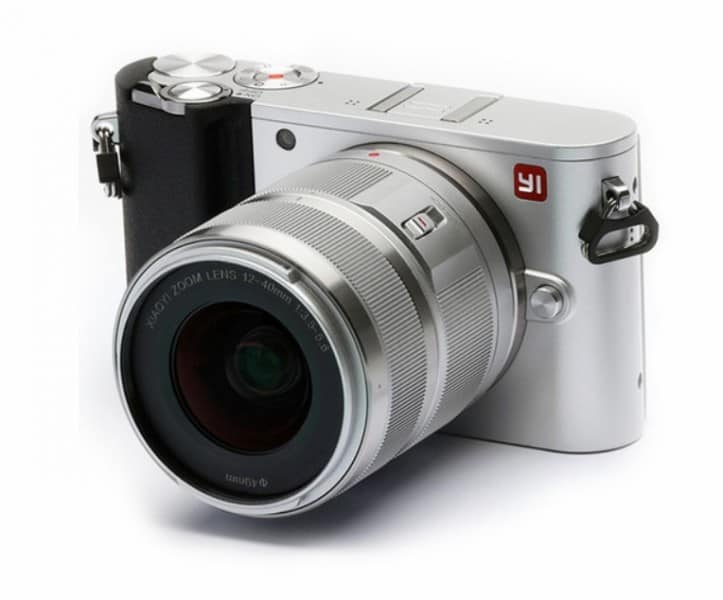Last Updated on June 30, 2020
Features
- 20.16MP Interchangeable Lens Camera
- IMX269 Sony Image Sensor
- MFT (Micro Four Thirds system)
- 4K (3840×2160) at 30fps
- ISO 25600 and 5 fps Continuous Shooting
- 3 inch, approx. 1.04MP Touchscreen LCD
- Built-In Wi-Fi & Bluetooth Connectivity
- Master Guide Templates
Yi M1 Introduction Video
Yi M1 Overview
If you aren’t ready to invest in a DSLR but want a camera that is levels better than what your smartphone can offer, the Yi M1 is worth looking at. It’s small enough to store in your bag and not large enough to attract attention.
This is Yi’s entry into the mirrorless camera market, and it comes after the company’s successful foray into action cameras. Their previous effort showed that it is possible to create a device with more or less the same features as established brands but offer it at almost half the price.
While all this is good news, is the camera any good?
Design & Features

Yi stands for “young innovators” and it looks like their mirrorless digital camera offering is tailored for that kind of audience. A lot of smartphones these days are capable of producing high-quality still images, but sometimes you just crave more.
The Yi M1 hopes to be the solution to that problem. With a user interface that is almost entirely operated by touch, the camera mimics actions you usually do with your smartphone. But of course, this model has more advanced features than your modern mobile device.
A mode dial helps switch between modes, while a control dial is available to set shutter and aperture. A minimalistic device, the M1 only has two buttons on the back, one is for playback and the other for AF selection.
Comfort is one of the best features of the M1 thanks to its compact body and lightness. In fact, the camera looks like a point-and-shoot rather than a mirrorless Micro Four Thirds camera.
User-friendliness is a feature most craved in devices and the M1 seems is doing rather well in that regard. It’s easy to find the shutter button by just feeling it out. Then again, this camera doesn’t work like those you have to bring to your eyes to compose a shot. But still, it’s good to know you can just feel out the shutter button to take a picture.
But the “finding by feel” easiness ends there as it’s not so convenient to switch to video mode. This is even though the video button is located at the center of the mode dial.

Now that might be a minor issue for some, but it can be a deal breaker for others. This is keeping in mind that the target audience of the M1 is users who want to move on from smartphone photography.
Plus, you will have to use the touch menu a lot since the camera doesn’t have a lot pf physical buttons to tinker with. But if you’re willing to deal with its slow UI then the M1 is sufficient enough to take quality photos.
The Yi M1 can take good quality video at 30fps, but runs into some cropping issues when shooting in 4K.
The $350 M1 base model comes with a 2-40mm f/3.5-5.6 zoom from Yi. Spending $100 more will get you the macro-capable 42.55mm f/1.8 prime lens. If you want both, you have to shell out $550.
Pros & Cons
Pros
- It is easy to use thanks to touchscreen driven menu operation.
- It produces excellent image quality.
- It doesn’t cost a lot for a camera in the Micro Four Thirds category.
Cons
- It doesn’t have the most responsive menu.
- It doesn’t have a lot of buttons which means that users have to really dig deep into the layers of the menu to find the features they want.
Final Thoughts
The Yi M1 is a pretty decent camera given its price. It takes quality photos and video. Although there are some issues with the UI, it can definitely provide the services needed by those who want to move on from mobile device photography.
| Focus Control | |
|---|---|
| Focus Type | Auto & Manual |
| Focus Mode | Continuous-Servo AF (C), Manual Focus (M), Single-servo AF (S), Touch AF & Shutter |
| Autofocus Points | Contrast Detection: 81 |
| Viewfinder/Display | |
|---|---|
| Viewfinder Type | None |
| Display Screen | 3″ Rear Touchscreen LCD (1,036,800) |
| Flash | |
|---|---|
| Flash Modes | Auto Flash On Off |
| Built-in Flash | No |
| Max Sync Speed | 1 / 125 Second |
| External Flash Connection | Hot Shoe |
| Performance | |
|---|---|
| Self Timer | 2 Seconds, 10 Seconds |
| Interval Recording | Yes |
| Internal Memory | None |
| Connectivity | HDMI D (Micro), Micro-USB |
| Wi-Fi Capable | Yes |
| Power | |
|---|---|
| Battery | 1Rechargeable Lithium-Ion Polymer Battery Pack900 mAh |
| Operating/Storage Temperature | Operating 14 to 104°F (-10 to 40°C) Humidity: 30 – 90% |
| Physical | |
|---|---|
| Dimensions (W x H x D) | 4.5 x 2.5 x 1.3″ / 113.5 x 64.3 x 33.6 mm |
| Weight | 9.877 oz / 280 g with battery |
| Packaging Info | |
|---|---|
| Package Weight | 2.45 lb |
| Box Dimensions (LxWxH) | 8.1 x 6.2 x 4.3″ |
Unboxing the Yi M1
User Reviews
Submit your review | |



